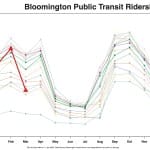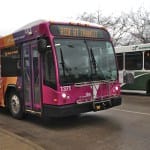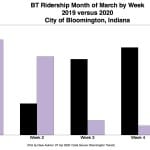Bloomington Transit still on path to April 21 decision on optimized routes for fall, service continues under COVID-19 curtailments, diminished ridership




In January, Bloomington Transit’s board got some good news. The 3.16 million rides taken on fixed route buses in 2019 reflected a 1.75-percent increase over the total from 2018.
It was the first year-to-year increase since 2014, after four straight years of decreases.
But due to the impact of the COVID-19 pandemic, it’s already apparent that the numbers for 2020 almost certainly won’t continue the upward trend. The roughly 180,000 rides taken in March this year reflect just about 60 percent of the the usual ridership, based on the last five years worth of data.
The first half of the month showed fairly normal ridership. But after Indiana University announced that spring break would be extended a week, then cancelled in-person instruction for the rest of the semester, ridership evaporated. Normally Indiana University affiliates—students, faculty and staff—make up about 70 percent of Bloomington Transit (BT) riders.
In the fourth week of March this year, just 8,437 rides were taken on fixed route buses. That’s about 10 percent of the 79,552 rides that were taken last year in the same week. By the end of April, BT ridership could already be down 400,000 rides or more, compared to last year.


The fare-free approach that BT has adopted during the COVID-19 pandemic is not meant to boost ridership so much as to reduce the need for any close person-to-person transactions between the driver and passengers when they board. The elimination of fares, for the time being, allows passengers to board through the rear door, which keeps driver-passenger interactions at a distance.
Federal and state reimbursements to local public transit agencies generally depend on ridership. In the recently enacted Coronavirus Aid, Relief, and Economic Security (CARES) Act, money is available to public transit agencies to help them cover expenses related to the impact of COVID-19.
According to the Federal Transit Administration, the $25 billion in CARES Act transit funding will cover operating expenses since the third week in January that go towards maintaining transit services. CARES Act money can also pay for administrative leave for transit workers, due to reduced operations during an emergency, according to the FTA.
BT operations have been reduced to the Saturday schedule for most routes with a couple of exceptions.
BT general operations manager Lew May told The Square Beacon that the Bloomington Transit board is still scheduled to meet on April 21, after cancelling its monthly meeting for March.
Although the agenda is not yet set, May thinks a decision on the route optimization plan for BT’s fixed route buses will appear as an item. The route optimization proposal is based on a consultant’s study done last year and was presented to the public at meetings held last year in November and December. Based on the public’s feedback, BT staff recommended adjustments to the proposed route configuration.
The route optimization plan had appeared on the cancelled March meeting agenda. The new routes are supposed to be implemented in August.
Will the pandemic protocols allow for resumption of normal service by August?
“It’s hard to know when normalcy will resume but I would hope it would happen sometime during the IU summer break which extends from early May to late August,” May told The Square Beacon. He added, “We’re still dealing with a great deal of uncertainty at this point.”





Comments ()